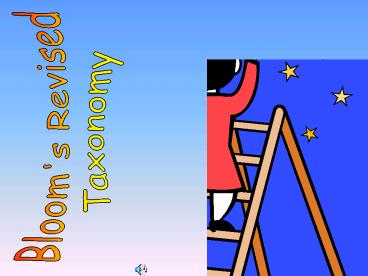BLOOM PowerPoint PPT Presentation
Title: BLOOM
1
Bloom's Revised Taxonomy
2
- The mind is not a vessel to be filled, but a fire
to be ignited. - (Plutarch)
3
What is Higher-order thinking?
- A guide to Productive Pedagogies Classroom
reflection manual states that - Higher-order thinking by students involves the
transformation of information and ideas. This
transformation occurs when students combine facts
and ideas and synthesise, generalise, explain,
hypothesise or arrive at some conclusion or
interpretation. Manipulating information and
ideas through these processes allows students to
solve problems, gain understanding and discover
new meaning. When students engage in the
construction of knowledge, an element of
uncertainty is introduced into the instructional
process and the outcomes are not always
predictable in other words, the teacher is not
certain what the students will produce. In
helping students become producers of knowledge,
the teachers main instructional task is to
create activities or environments that allow them
opportunities to engage in higher-order thinking. - (Department of Education, Queensland, 2002, p. 1)
4
Blooms Revised Taxonomy
- Taxonomy of Cognitive Objectives
- 1950s- developed by Benjamin Bloom
- Means of expressing qualitatively different kinds
of thinking - Adapted for classroom use as a planning tool
- Continues to be one of the most universally
applied models - Provides a way to organise thinking skills into
six levels, from the most basic to the higher
order levels of thinking - 1990s- Lorin Anderson (former student of Bloom)
revisited the taxonomy - As a result, a number of changes were made
- (Pohl, 2000, Learning to Think, Thinking to
Learn, pp. 7-8)
5
Original Terms New Terms
- Evaluation
- Synthesis
- Analysis
- Application
- Comprehension
- Knowledge
- Creating
- Evaluating
- Analysing
- Applying
- Understanding
- Remembering
(Based on Pohl, 2000, Learning to Think, Thinking
to Learn, p. 8)
6
BLOOMS REVISED TAXONOMYCreatingGenerating new
ideas, products, or ways of viewing
thingsDesigning, constructing, planning,
producing, inventing. EvaluatingJustifying a
decision or course of actionChecking,
hypothesising, critiquing, experimenting,
judging AnalysingBreaking information into
parts to explore understandings and
relationshipsComparing, organising,
deconstructing, interrogating, finding Applying
Using information in another familiar
situationImplementing, carrying out, using,
executing UnderstandingExplaining ideas or
conceptsInterpreting, summarising, paraphrasing,
classifying, explaining RememberingRecalling
informationRecognising, listing, describing,
retrieving, naming, finding
Higher-order thinking
7
Remembering
- The learner is able to recall, restate and
remember learned information. - Recognising
- Listing
- Describing
- Identifying
- Retrieving
- Naming
- Locating
- Finding
- Can you recall information?
8
Understanding
- The learner grasps the meaning of information by
interpreting and translating what has been
learned. - Interpreting
- Exemplifying
- Summarising
- Inferring
- Paraphrasing
- Classifying
- Comparing
- Explaining
- Can you explain ideas or concepts?
9
Applying
- The learner makes use of information in a
context different from the one in which it was
learned. - Implementing
- Carrying out
- Using
- Executing
- Can you use the information in another
- familiar situation?
10
Analysing
- The learner breaks learned information into its
parts to best understand that information. - Comparing
- Organising
- Deconstructing
- Attributing
- Outlining
- Finding
- Structuring
- Integrating
- Can you break information into parts to explore
understandings and relationships?
11
Evaluating
- The learner makes decisions based on in-depth
reflection, criticism and assessment. - Checking
- Hypothesising
- Critiquing
- Experimenting
- Judging
- Testing
- Detecting
- Monitoring
- Can you justify a decision or course of action?
12
Creating
- The learner creates new ideas and information
using what has been previously learned. - Designing
- Constructing
- Planning
- Producing
- Inventing
- Devising
- Making
- Can you generate new products, ideas, or ways of
viewing things?
13
How does it all fit together?
Multiple Intelligences/ Smarts
Multiple Intelligences/ Smarts
Thinking Skills
Blooms Revised Taxonomy
Thinker's Keys
Six Hats
14
- He who learns but does not think is lost
- (Chinese Proverb)

